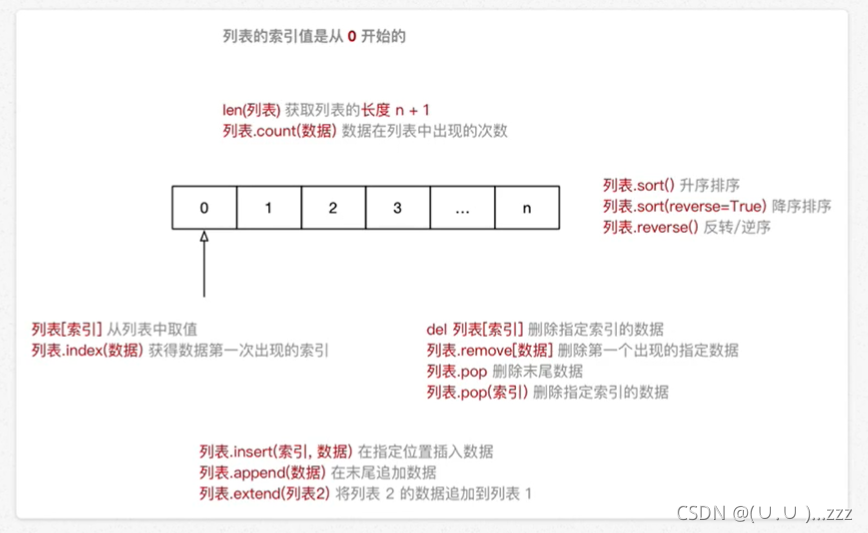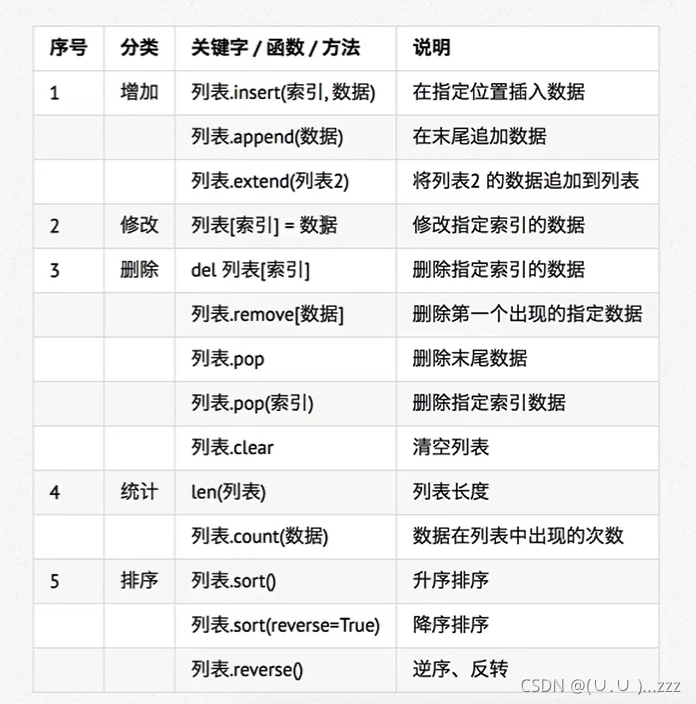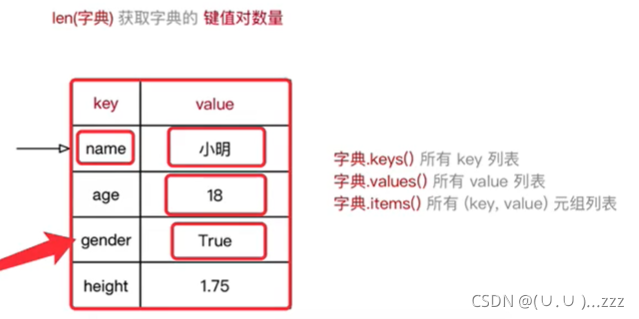这里写自定义目录标题
- 列表 list
- 常用操作
- 循环遍历
- 元组 Tuple
- 常用操作:取值取索引、计数
- 元组的应用场景
- 元组、列表 的转换
- 字典 dictionary
- 字典 常用操作:增删改查
- 统计、合并
- 字典的遍历
- 字典和列表
列表 list
- 其他语言中——数组
- 存储一串信息
- [x,y,z]
- 列表的索引从0开始
- 不可超出所应范围,会报错
常用操作


list01 = ["1","2","3","3","2","6"]
# del 是从内存中删除
del list01[1]
print(list01)
# 统计长度
print(len(list01))
# 统计出现几次
count = list01.count("3")
print(count)
# remove 列表中第一个出现的
list01.remove("3")
print(list01)
# 排序
# 升序
list01.sort()
print(list01)
# 降序
list01.sort(reverse=1)
print(list01)
# 反转
list01.reverse()
print(list01)
循环遍历
list02 =["2","3","4"]
for i in list02:
print(i)
2
3
4
元组 Tuple
- 与list相似,但元素不能修改
- (x,y,z)
- 索引从0开始
- 创建空元组 tuple=()
- 通常存储不同类型的数据
tuple =("woai",1,0.99)
print(type(tuple))
# python解释器,直接认为是数据类型
# <class 'int'>
t=(2)
print(type(t))
# 要定义一个只包含一个元素的元组
# 要跟上逗号
# <class 'tuple'>
t1=(2,)
print(type(t1))
常用操作:取值取索引、计数
t = ("where are you now",1,2,2)
# 取值
print(t[0]) # where are you now
# 取索引
print(t.index("where are you now")) # 0
# 统计计数
print(t.count(2)) # 2
# 统计元组中元素的个数
print(len(t)) # 4
元组的应用场景
- 元组可作为函数的参数、返回值
- 格式字符串,本质上就是元组
- 让列表不可以被修改,保护数据安全
tuple1 = ("aaa",21,188)
print("%s 年龄是%d的身高是%d" % tuple1)
tuple1str = "%s 年龄是 %d的身高是%d"%tuple1
print(tuple1str)
元组、列表 的转换
# <class 'tuple'>
t = (1,23,34)
print(type(t))
# <class 'list'>
list(t)
print(type(list(t)))
字典 dictionary
- 列表是有序的 对象集合
- 字典是无序的 对象集合
{x,y,z}- 键值对 键:值

dict = {"name":"gggg",
"age":20,
"height":190
}
print(dict)
# {'name': 'gggg', 'age': 20, 'height': 190}
# 打印顺序可能和字典的顺序不一致
字典 常用操作:增删改查
dict = {"name":"gggg",
"age":20,
"height":190
}
print(dict)
print("取值:",end="")
print(dict["name"])
print("增加、修改:",end="")
dict["weight"]=200 # key不存在,新增键值对
dict["name"]="ggg" # key存在,修改为小小明
print(dict)
print("删除:",end="")
dict.pop("name")
print(dict)
{'name': 'gggg', 'age': 20, 'height': 190}
取值:gggg
增加、修改:{'name': 'ggg', 'age': 20, 'height': 190, 'weight': 200}
删除:{'age': 20, 'height': 190, 'weight': 200}
统计、合并
dict = {"name":"gggg",
"age":20,
"height":190
}
# 键值对的数量
print("键值对的数量")
print(len(dict))
# 合并字典
# {'name': 'gggg', 'age': 20, 'height': 190, 'perfer': 111}
temp_dict = {
"perfer":111
}
dict.update(temp_dict)
print(dict)
# 清空字典
dict.clear()
print(dict)
字典的遍历
for i in dict:
print("%s-%s"%(i,dict[i]))
字典和列表
字典嵌在 列表中